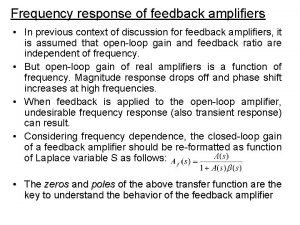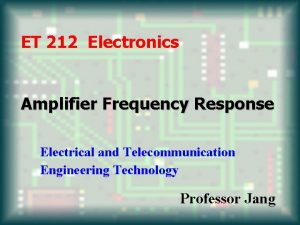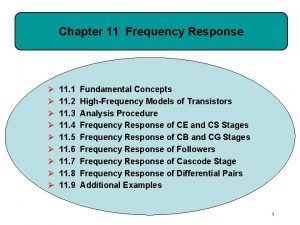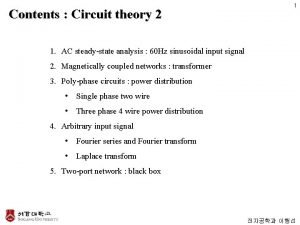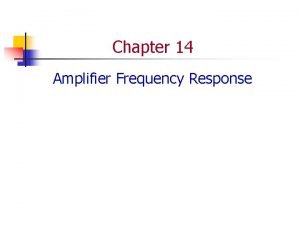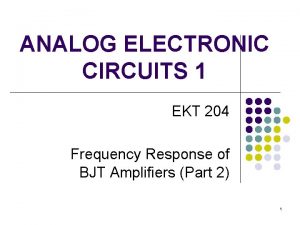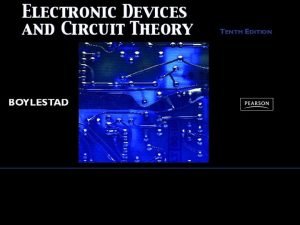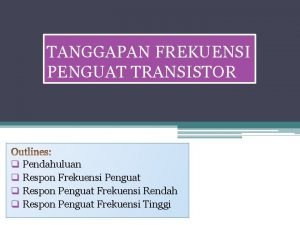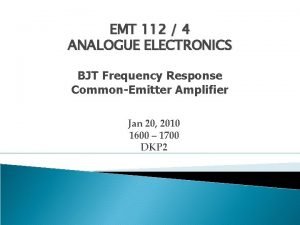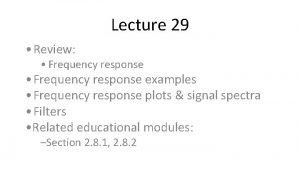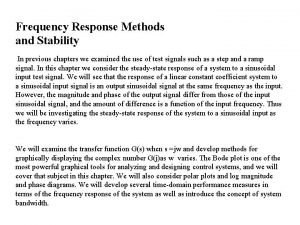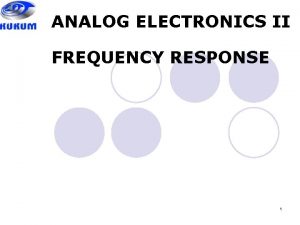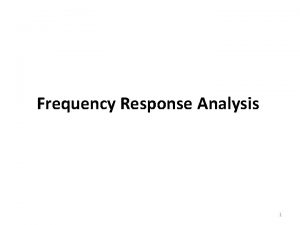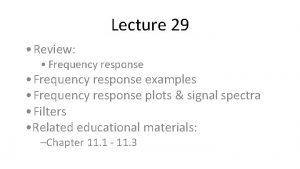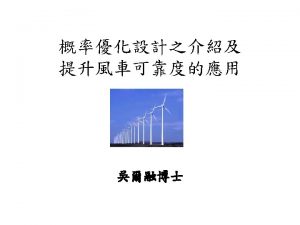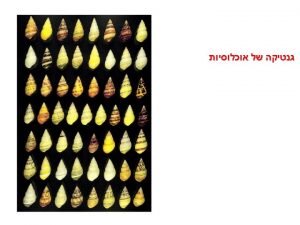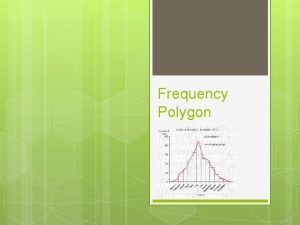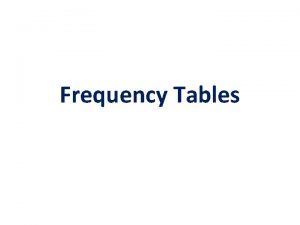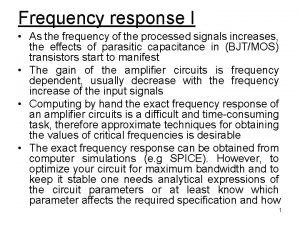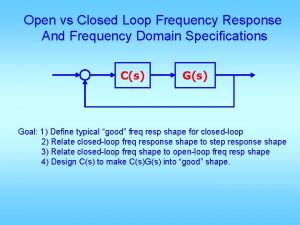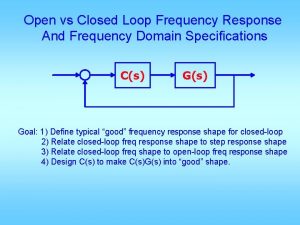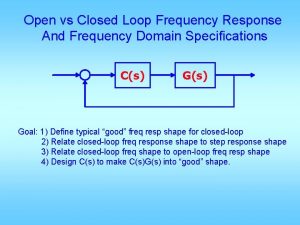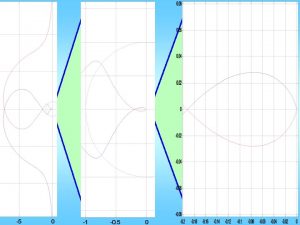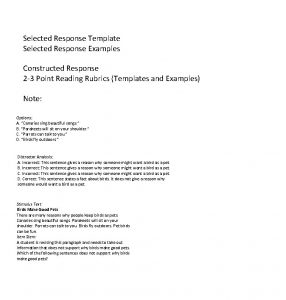Frequency response I As the frequency of the





















- Slides: 21

Frequency response I • As the frequency of the processed signals increases, the effects of parasitic capacitance in (BJT/MOS) transistors start to manifest • The gain of the amplifier circuits is frequency dependent, usually decrease with the frequency increase of the input signals • Computing by hand the exact frequency response of an amplifier circuits is a difficult and time-consuming task, therefore approximate techniques for obtaining the values of critical frequencies is desirable • The exact frequency response can be obtained from computer simulations (e. g SPICE). However, to optimize your circuit for maximum bandwidth and to keep it stable one needs analytical expressions of the circuit parameters or at least know which parameter affects the required specification and how 1

Frequency response II • The transfer function gives us the information about the behavior of a linear-time-invariant (LTI) circuit/system for a sinusoidal excitation with angular frequency • This transfer function is nothing but the ratio between the Fourier transforms of the output and input signals and it is also called the frequency response of the LTI circuit. • represents the gain magnitude of the frequency response of the circuit, whereas is the phase of frequency response. Often, it is more convenient to express gain magnitude in decibels. • To amplify a signal without distortion, the amplifier gain magnitude must be the same for all of the frequency components 2

Frequency response of amplifers • • • A bode plot shows the gain magnitude and phase in decibles versus frequency on logarithmic scale A few prerequisites for bode plot: Ø Laplace transform and network transfer function Ø Poles and zeros of transfer function Ø Break frequencies Some useful rules for drawing high-order bode plots: Ø Decompose transfer function into first order terms. Ø Mark the break frequencies and represent them on the frequency axis the critical values for changes Ø Make bode plot for each of the first order term Ø For each first order term, keep the DC to the break frequency constant equal to the gain at DC Ø After the break frequency, the gain magnitude starts to increase or decrease with a slope of 20 db/decade if the term is in the numerator or denominator Ø For phase plot, each first order term induces a 45 degrees of increase or decrease at the break frequency if the term is in the numerator or denominator Ø Consider frequencies like one-tenth and ten times the break frequency and approximate the phase by 0 and 90 degrees if the frequency is with the numerator (or 0 and -90 degrees if in the denominator) 3 Ø Add all the first order terms for magnitude and phase response

Frequency response of RLC circuits E. g. 1 E. g. 2 E. g. 3 4

The MOS Transistor Polysilicon Aluminum 5

The Gate Capacitance Polysilicon gate Source xd n+ xd Ld W Drain n+ Gate-bulk overlap Top view Gate oxide tox n+ L n+ Cross section view 6

Gate Capacitance Cut-off Resistive Saturation Most important regions in digital design: saturation and cut-off 7

Diffusion Capacitance Channel-stop implant N A 1 Side wall Source ND W Bottom xj Side wall LS Channel Substrate N A 8

Frequency response of common source MOS amplifer High-frequency MOS Small-signal equivalent circuit MOSFET common Source amplifier Small-signal equivalent circuit for the MOS common source amplifier Frequency response analysis shows that there are three break frequencies, and mainly 9 the lowest one determines the upper half-power frequency, thus the -3 db bandwidth

Exact frequency response of amplifiers • Exact frequency analysis of amplifier circuits is possible following the steps: ØDraw small-signal equivalent circuit (replace each component in the amplifier with its smallsignal circuit) ØWrite equations using voltage and current laws ØFind the voltage gain as a ratio of polynomial of laplace variable s ØFactor numerator and denominator of the polynomial to determine break frequencies ØDraw bode plot to approximate the frequency response 10

The Miller Effect • Consider the situation that an impedance is connected between input and output of an amplifier Ø The same current flows from (out) the top input terminal if an impedance is connected across the input terminals Ø The same current flows to (in) the top output terminal if an impedance is connected across the output terminal Ø This is know as Miller Effect Ø Two important notes to apply Miller Effect: ü There should be a common terminal for input and output ü The gain in the Miller Effect is the gain after connecting feedback impedance 11 Graphs from Prentice Hall

Application of Miller Effect • If the voltage gain magnitude is large (say larger than 10) compared to unity, then Øwe can perform an approximate analysis by assuming is equal to Øfind the gain including loading effects of Øuse the gain to find out Thus, using Miller Effect, gain calculation and frequency response characterization would be much simpler 12

Application of Miller Effect • If the feedback impedance is a capacitor , then the Miller capacitance reflected across the input terminal is. • Therefore, connecting a capacitance from the input to output is equivalent to connecting a capacitance • Due to Miller effect, a small feedback capacitance appears across the input terminals as a much larger equivalent capacitance with a large gain (e. g. ). At high frequencies, this large capacitance has a low impedance that tends to short out the input signal 13

BJT small-signal models (for BJT amplifiers) The model for low-frequency analysis The model for high-frequency analysis The base-spreading resistance for the base region (very small) The dynamic resistance of the base emitter region The feedback resistance from collector to base (very large) Account for the upward slope of the output characteristic The depletion capacitance of the collector-to-base region The diffusion capacitance of the base-to-emitter junction Note: in the following analysis of the CE, EF and CB amplifier in the next three slides, we will assume for simplicity (though they still appear in the small signal models). 14

Miller Effect: common emitter amplifier I 15

Miller Effect: common emitter amplifier II Assume the current flowing through is very small compared to , then the gain will be considering the input terminal of the amplifier at b’ to ground. Applying the miller effect for the amplifier, the following simplified circuit can be obtained: Thus, the total capacitance from terminal b’ to ground is given as follows (neglect the miller capacitance from output terminal c to ground): The break frequency, thus the -3 db frequency is set by the RC lowpass filter (other voltage controlled current source, resistance does not contribute to the 16 break frequency). is a main limiting factor for -3 db bandwidth.

Emitter-follower amplifier • Using Miller Effect, we obtain the above equivalent circuit. If neglecting , It shows that the break frequency is 17

Common base amplifier • What about amplifier that do not have capacitance connected directly from output to the input? For approximate analysis, we can neglect the simplified equivalent circuit can be shown in (c). Derive the transfer function for this circuit, it shows two break frequencies (with typical values, is approximately -3 db bandwidth) 18

Cascode amplifier and differential amplifier • The cascode amplifier can be viewed as a common-emitter amplifier with a common-base amplifier. • Due to low input impedance of Q 2, the voltage gain of Q 1 is small. So, Miller effect on Q 1 is small. • The Emitter-coupled differential amplifier can be viewed as a emitter-follower amplifier cascaded with a common-base amplifier (both have wider bandwidth than common-emitter amplifier). Graphs from Prentice Hall 19

Differential amplifier with active loads • The amplifier in (a) is a single-ended amplifier. The break frequencies are: 20 Graphs from Prentice Hall

Differential amplifer with active loads • The amplifier in (b) is a fully differential amplifier. The break frequencies are: 21 Graphs from Prentice Hall
 Natural response and forced response
Natural response and forced response Natural and forced response
Natural and forced response A subsequent
A subsequent Frequency response of feedback amplifier
Frequency response of feedback amplifier Advantages of multistage amplifier
Advantages of multistage amplifier Frequency response curve of an amplifier
Frequency response curve of an amplifier Source follower frequency response
Source follower frequency response Circuit theory 2
Circuit theory 2 Amplifier cutoff frequency
Amplifier cutoff frequency Frequency response cbe
Frequency response cbe Bjt frequency response
Bjt frequency response Tanggapan frekuensi tinggi penguat transistor bipolar
Tanggapan frekuensi tinggi penguat transistor bipolar Formula for cutoff frequency
Formula for cutoff frequency Magnitude and phase response
Magnitude and phase response Mti versus pulse doppler radar
Mti versus pulse doppler radar Nichols plot stability
Nichols plot stability How is linear frequency related to angular frequency?
How is linear frequency related to angular frequency? How to find conditional relative frequency
How to find conditional relative frequency Frequency vs relative frequency
Frequency vs relative frequency Observed frequency
Observed frequency Marginal frequency distribution
Marginal frequency distribution Peak factor formula
Peak factor formula



